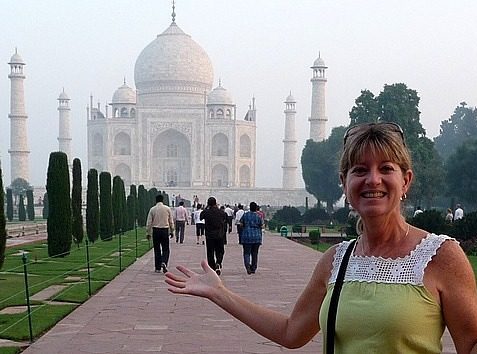Bagan, Myanmar
So my last full day in Bagan promised to be fun. I shook off the gloomy feeling, had a lovely breakfast and joined Zaw and Mr. Tin for a drive to the jetty. We were going for a boat ride across the Ayeyarwady River to see a couple villages on the river bank across from Bagan. We climbed into the little boat while the young boat owner started the diesel engine and maneuvered the boat out from the crowd of boats at the jetty. We were off.

The young captain had set out a little spread for us to enjoy consisting of tea, tea leaf jsalad with palm oil, peanuts, soy nuts and garlic (actually very, very good) with some green tea and roasted nuts.
The ride across the river was actually pretty quick as we were travelling with the tide. We passed the waterfront stupa Bupaya (where I had bought some homemade candy from a woman before my little fall on Monday), and a number of fishermen and kids playing in the water. (I don’t think school attendance is strictly enforced here.)

We reached the other side and our captain turned out to be equally skillful in maneuvering the boat into the sandy beach. Once we were secured to the beach, we climbed off the little boat and up the sandy hillside. It had rained heavily overnight on this side of the river so there were sandy puddles everywhere. Nevertheless we were off.
We immediately found ourselves on a path between a series of wooden houses on stilts (the area floods during the rainy season) and cows were everywhere. Under porches, sitting in the middle of the sandy path, wandering down the path and grazing in the fields. It was cow mania. Apparently the cows were used solely for plowing, not meat or milk.

The other thing that was striking was that many of the homes had small solar panels attached to the homes. This is not the first time I have seen solar panels in the villages of Myanmar. We saw a few in the first Chin village I visited in Rakhine State.
I asked one of the locals how much a solar panel cost and was told $100 USD. Now given the fact that the average wage in Myanmar is 3500 kyat (about $2.50) per day, that was a helluva lot of money to save.

As we moved on, we passed villagers sitting in their backyard, pumping water, sewing on sewing machines, chasing chickens, walking with their children and doing laundry. The best part was as we walked, the women who were working outside were singing. I have no idea what they were singing, but the sound of these lovely lilting voices were everywhere as we walked. It was lovely.
We finally came to an impassible stretch of the path and the owners of an adjacent house let us walk through his garden to a new path that took us to the outer stretches of the village. We could hear the sound of a lot of children laughing and talking so we knew we were near a school.

As we crossed the fields and past yet another set of houses, we began to see a lot of dogs. I figure the dogs were there to protect the crops. As we turned to start back towards the jetty, one large German shepherd decided he did not like the looks of us. He started moving towards us with a low growl and then let of a series of barks and starts running towards us. Uh oh.

Fortunately, Zaw was carrying a very long pointy umbrellla that he used to challenge the dog with as I continued to walk at a what I can only describe as the fastest walk I could muster. The owners of the dog apparently heard the commotion and came out and started hollering at the dog. By this point both Zaw and I were well past the house and almost back to the main path. Yikes. While we both laughed about it, I envisioned needing stitches in my other calf!
So we wandered back to the boat and by this time the daily low cloud was clearing out and giving way to lovely sunshine. The boat ride back was much slower as we were traveling against the tide, but as always, I loved being on the water.

After we docked, I asked Zaw if he could arrange a horse cart for me for the afternoon. I was going it alone, without a guide, and wanted to see some of the smaller temples and pagodas that apparently had brilliant frescoes and original Buddah statutes, much like Mrauk U. Zaw put in a call to a reliable horse cart driver and by 1:00 p.m., Bo Bo had arrived with his horse cart being pulled by a chestnut horse named Nanda. Bo Bo spoke pretty good English so I hopped onto the cart and off we set.
Now I must say that the seating in this cart was far superior to the cart I road in in Inwa. There was actually a thick foam pad and lots of space to sit.
Anyway, I had given Zaw a list of 4 pagodas and temples I wanted to see and Bo Bo recommended a few others. After a brief discussion of where we were going, Bo Bo, Nanda and I set off. We clopped along the dirt road through New Bagan, past open air shops, little hotels, restaurants and lacquer shops and down the flooded road (it had been flooded the entire time I was in Bagan). As we hurkey jerked along, people zipped by us on E-Bikes, motorcycles, cars and trucks. Now I don’t know what it is about the horse carts, but everyone who passed us would smile and wave at me. This was great fun.

We finally turned down a narrow tree lined lane past a monestary built on stilts where a number of young novice girls dressed in pink with shaved heads were in the yard doing laundry under the trees. They all waved as we passed by, and I waved back. We turned a bend and there it was: Lawkananda Paya. My first stop for the afternoon. This stupa was built in 1059 near the southern part of New Bagan right above the Ayeyarwady River. The stupa was still used as a place of worship and is thought to house an important Buddha tooth replica. Unfortunately for me, the stupa had been damaged in the August 2016 earthquake and was covered in bamboo scaffolding.
I wandered around the circumference of the stupa and spent some time looking at the views. There were groups of kids everywhere, and I was not sure if they were paying respects or hanging out. There really wasn’t much to see here, but the views were lovely and bonus … there were lots of vendors selling street food.
So as I wandered down the cement steps to leave the temple, I was surrounded by a group of older ladies who all wanted their picture taken with me. One put her arm around me, one stood on the stairs to be as tall as me, and on and on. I wasn’t sure it was going to end. When it finally did, one of the ladies asked in broken English “where you live”? “I live in Seattle USA”. The lady shook her head and said “Ahh Trump Trump”. I looked at her shook my head with her and bust into tears. The poor woman looked at me and instinctively put her arms around me and gave me a hug. Bless her soul.

I finally waved goodbye to the ladies and went over to look for some street food. I found a young woman with a platter full of deep fried prawns and boiled prawns. I paid 2,000 kyat for four boiled prawns and four skewers of deep fried prawns. The young woman put my purchases in a bag, posed for a picture and off I went.
I found the horse cart, climbed aboard and offered Bo Bo some food. He declined. At that point, I was wishing I could find some carrots for Nanda, but so far I had not seen any vegetable vendors.
We set off next for Lay May Hnat Temple. There was nothing particularly noteworthy about this temple, except that there was a terrace that afforded a great view. Nanda clop clop clopped down the road as E-bikes and motorcycles whizzed by and I stared at the unarmed stupas that surround me on the ride.
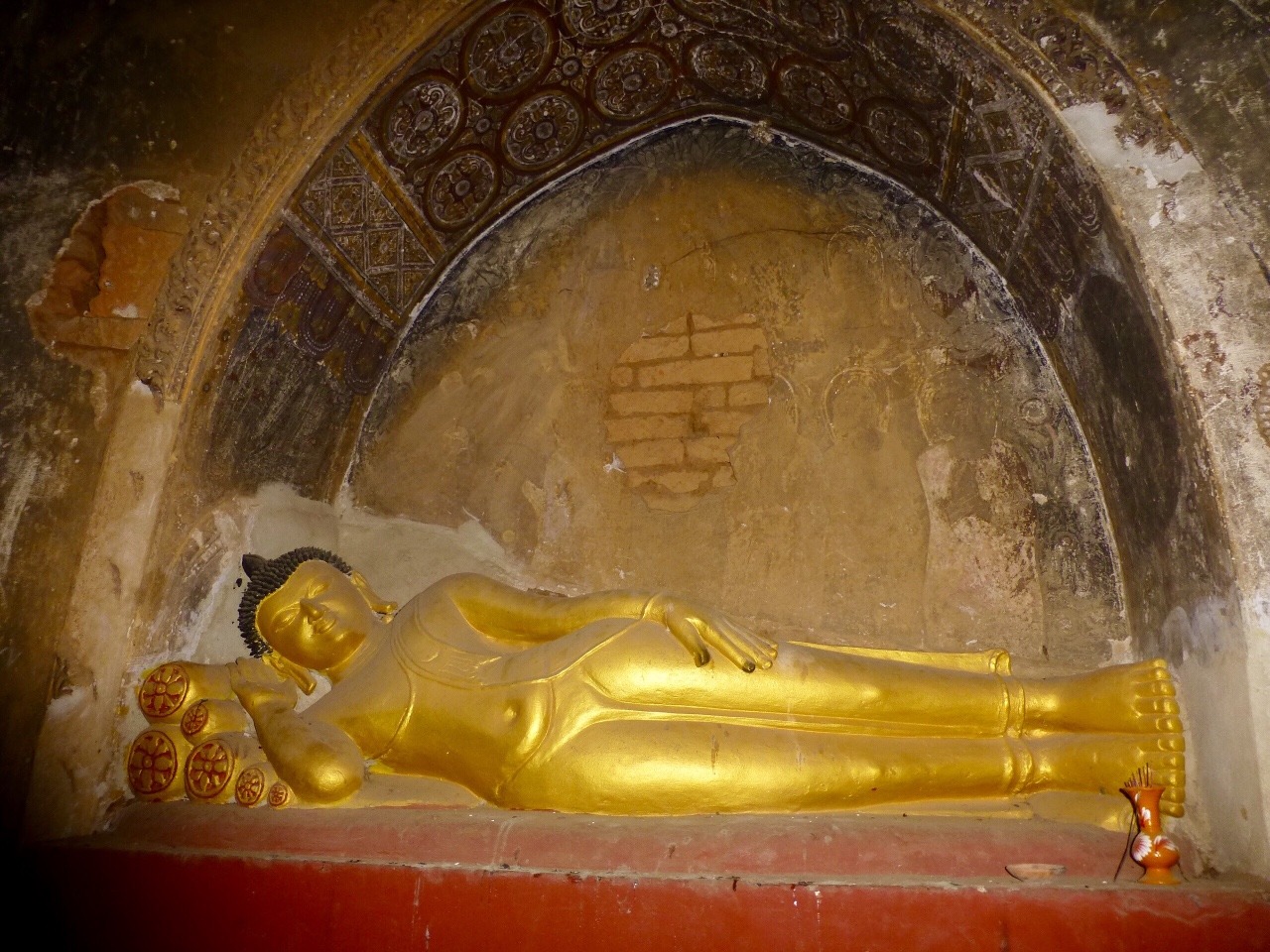
When we arrived at the temple, it was locked. So a guy with a key opened the door to the temple and followed me around for a bit pointing out some remnants of frescoes on the walls and where to go to climb to the terrace. I gave him a couple thousand kyat for the help and he eventually left me alone.
Now I will say that the views around the area were spectacular and totally worth the climb. Vast fields dotted with ancient temples and stupas and in the distance music from a wedding.

After a few pictures, I made my way down the narrow staircase, dipped my head twice so I would not bump my head on the low ceilings and jumped back on the horse cart for a quick one minute (maybe less) drive to the next temple, which turned out to be one of my favourites of the day: Nagayon Paya. This temple had been built in 1192 and was chock full of frescoes and original Buddahs.

As I wandered around along the very smooth stone floors with my flashlight, I could make out dancing women, fair skinned and darker skinned men, temples and stupas, birds and lotus flowers painted on the walls and ceilings. The colours were was still quite bright on many of the paintings with vivid blues, reds, black and whites.
The really nice thing about this temple was there was a fair bit of nature light flowing from little cross shaped window cutouts built into the alcoves in the four sides of the temple. As a result, it was often very easy to make out the painted shapes and patterns that lined the ceiling alcoves above each window. One alcove in particular looked as if the entire ceiling made of black, white and gold lotus flowers was entirely intact.


The Buddahs were also spectacular, albeit very dusty, many displaying original colours, some standing, some sitting. This temple took me back to Mrauk U and was clearly the best temple I had seen to date in terms of original content and design. I loved it. And the strange thing … I did not see any tourists until I walked out side and a British couple asked me if it was worth a look. Uh that would be a yes.

So by now, I’m sure that Bo Bo thought I had gotten lost. So once back on the horse cart, we drove down the road past more unnamed temples and tall grasses to Apeyadana Paya. The temple was build in the 11th century. Unfortunately, no pictures were permitted, but what I saw in side was stunning. The colours on the paintings in this temple were even better than the last temple, with various shades of blue and bright, vivid reds. Unfortunately, though, the temple niches were, for the most part, empty of original Buddahs. Nevertheless, the beautiful frescoes more than made up for the lack of statutes.
When I had arrived at the temple, an Italian tour group of about 20 people had just disembarked a bus. I walked inside with them and walked in the opposite direction and began examining the frescoes on the walls and ceilings. Now I don’t know what these folks were looking at, but they were in and out in about 5 minutes. Huh? I spent 5 minutes looking at one small little mural. The detail in this place was simply unbelievable. There were elephants and birds and Hindu gods like Brahma, Vishnu, Shiva and Indra.

So as I walked along the cobble stone flooring down one side of the square interior to the next, I soon discovered that some of my favourite scenes were of women dancing and using different poses with their arms. The fascial expressions on each were unique as were the poses. The amount of work that went into these frescoes was astounding. It was a really special place.

So after I was done at Apeyadana we proceeded on down the road towards the village of Myinkaba, which was about half way between Old Bagan and New Bagan. My next stop was at Nanpaya Temple. This temple restricted access to the front part of the temple. Nevertheless, it was still possible to view four beautiful stone pillar sandstone bas-relief figures of three-faced Brahma holding lotus flowers. The carvings were really lovely and very well preserved. The only drawback of this place …. to get into the temple you had to avoid a phalanx of vendors. Now at this point, I was used to seeing vendors at some of the top spots, and most were very respectful and lovely when you said no. However, this group was absolutely brutal. They followed you up the steps. They followed you towards they entrance. They followed you into the temple alcove. And no was not a word than any of them understood.
And there was apparently some system in place where the vendor attached themselves to a tourist, claimed they were a student studying history and that they needed the tourist to buy something so they could continue to go to school. The vendors badgered tourists nonstop to visit “their shop”. Now the gal who attached herself to me kept getting in the way of my pictures. She finally got the message when I stopped responding to her and simply walked down the stairs and put my sandals back on.
However, one lovely young fellow from Britain could not shake the vendor. She followed him down the stair waving a box at him. She then shoved it in his face as he was putting his sandals on all the while politely saying no. She even followed him down the street still waiving the box while he said no. The vendor finally turned around and yelled what I presume was some kind of Burmese curse word and stomped back past me to wait for her next victim. My God. I had no seen such aggressive sales pitches since I had arrived. These women rivaled the folks at the stands in the Valley of the Kings in Egypt.
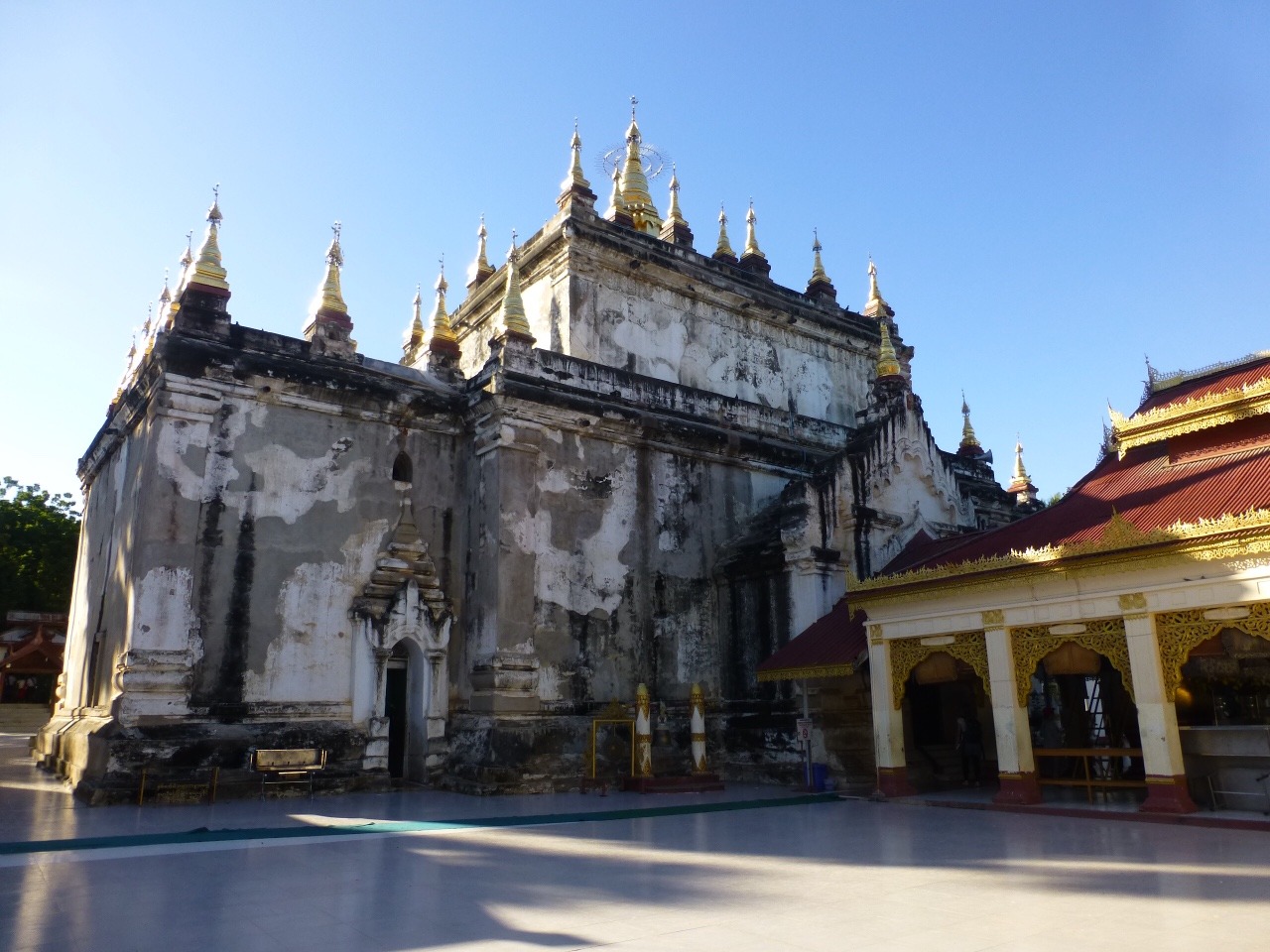
So I escaped this hassle unscathed and walked the half block to my next stop: Manua Paya. This temple sits in the middle of Myinkaba village and looks like it could have been built recently. However, the sign said the temple dated to 1059.
Now this temple did not have any frescoes, but what it did have was amazing and I mean amazing, giant Buddahs. There were three seated Buddahs in the front portals of the temple. I then went outside and walked around to the backside of the temple where I entered a room the length of the temple to find an enormous reclining Buddah. The weird thing about the Buddahs is each one of the portals is that they filled the entire room they occupied. In fact, I actually had to turn sideways to get by the first seated Buddah to move to the next enclosure. It was really crazy.
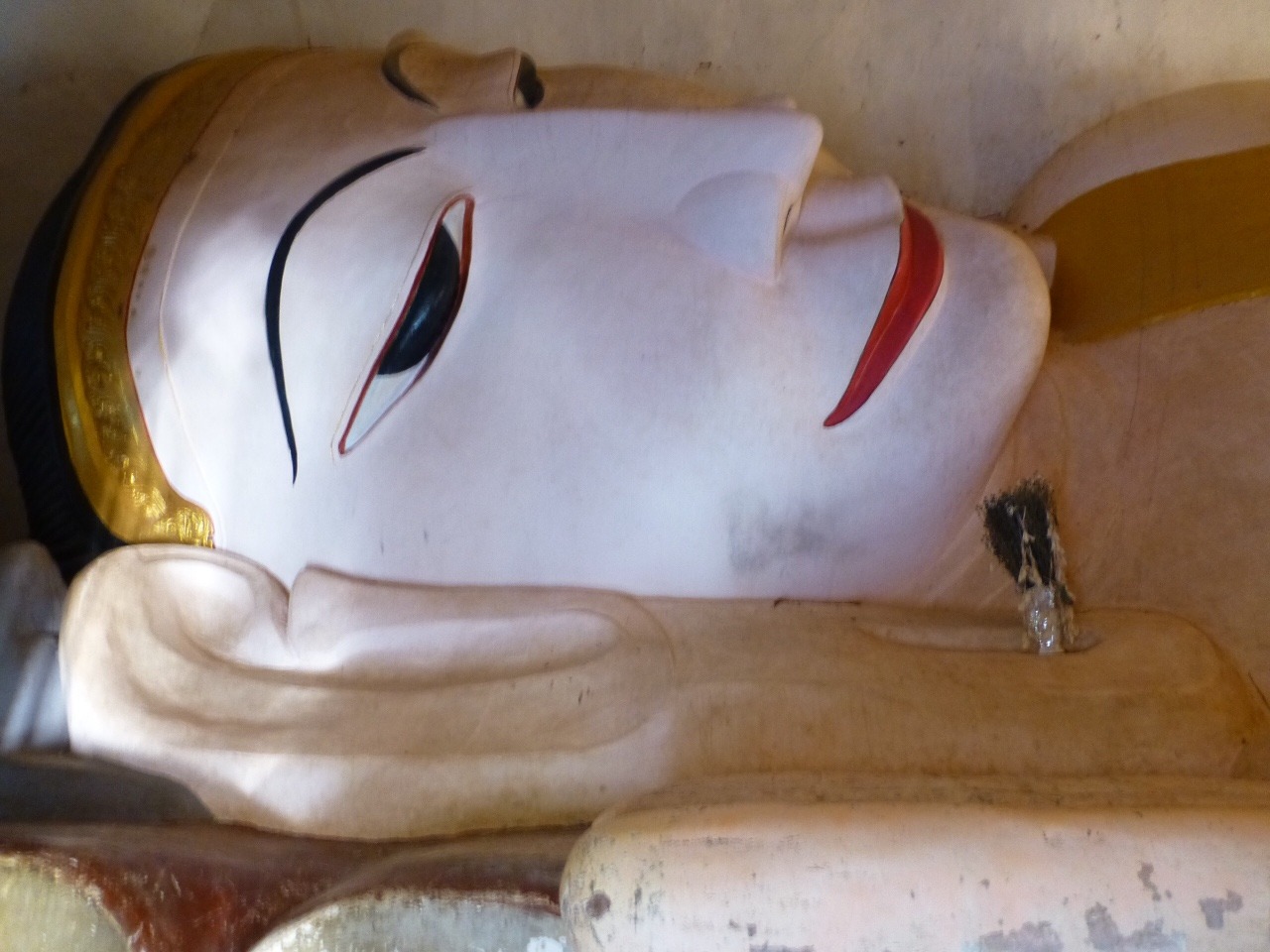
Before I left Manua Paya, I climbed to the top of the temple and peered through a room to look at the middle Buddah’s face. This again was one of those trick Buddahs. Down below he did not look like he was smiling, but from above, a huge grin. Those tricky Buddhists.

So after viewing the monster Buddahs and climbing yet another set of stairs, I began to hunt for some water. I was dying of thirst and had already finished off all the water I had brought with me. I found a water stand in front of a bunch of road workers outside the temple. I paid for the largest bottle the vendor had and stood their and guzzled the entire bottle. I was so hot (I will never adjust to this heat and humidity) and so thirsty I didn’t realize that the workers were all watching me. As it turned out, my water guzzling was huge entertainment because as I finished off the bottle, the five men staring at me burst into applause. I started laughing with them and then received a series of high fives. Just another in a long line of lovely moments in Myanmar involving the wonderful people of this country.
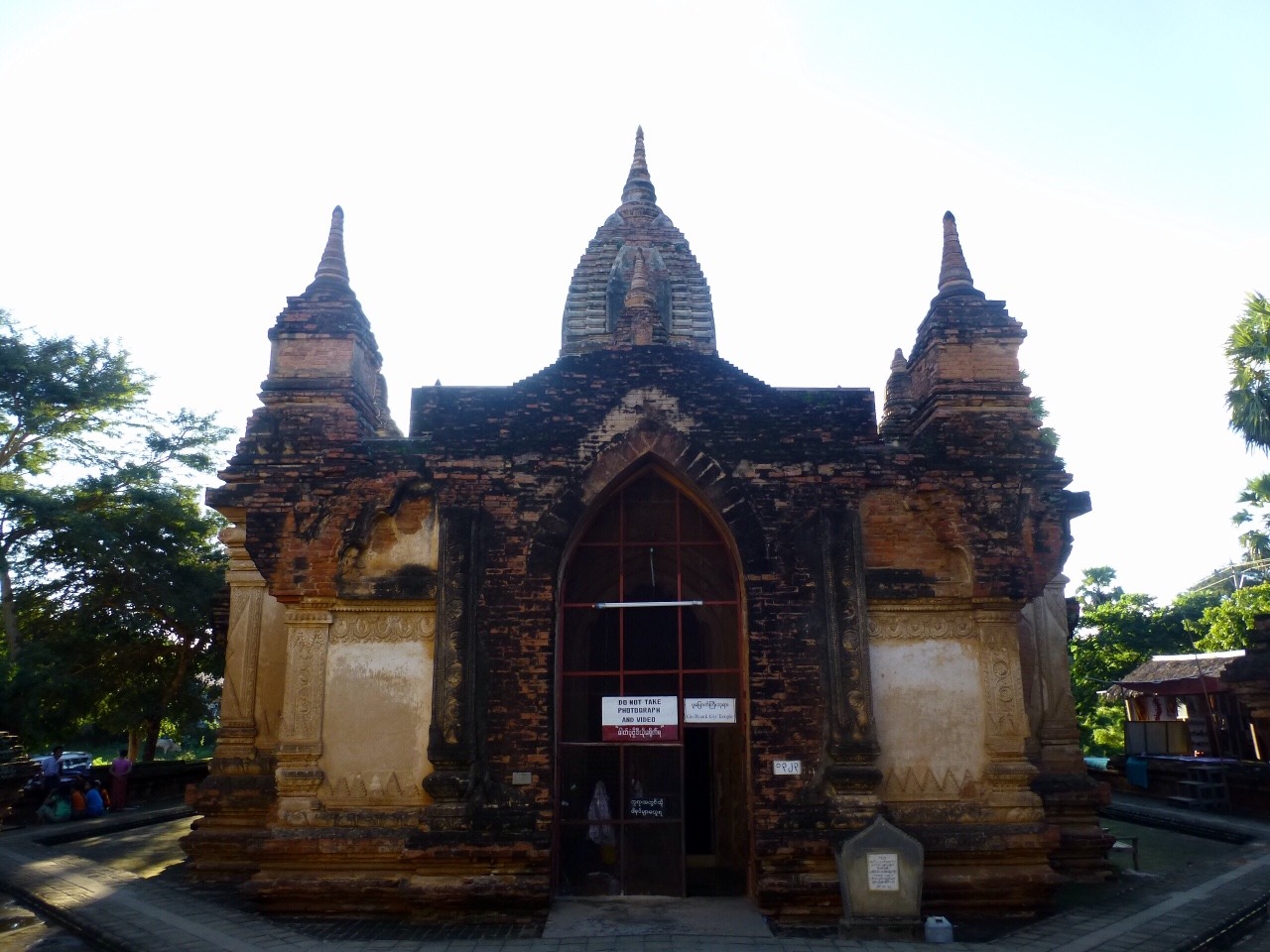
So once hydrated, I found Bo Bo and Nanda and we set off in the direction of Gubyaukgyi Paya on the opposite site of the road from Manu Paya and a few clips down the street. The “Great Painted Cave” temple was constructed in 1113 and is, as the name implies, teaming with amazing paintings and frescoes inside. This was another of those “no pictures” temples and boy do they mean it. When I was standing outside the temple, I pulled out my camera to take a picture of the exterior of the temple, and two old ladies sitting in the portal entry yelled at me “No pictures” “No pictures” and pointing at the sign. I nodded and then proceeded to raise my camera. And again “No pictures”. “No pictures”. “Yes, yes. I understand, but that is inside.” (Flash photography can ruin the fragile paintings.).
Well these ladies were having none of it. They had apparently been taught two English words and told to do a job and by God they were going to do it. So I ended up walking to the far side of the courtyard and zooming in to get a shot, and then putting away my camera and walking back across the courtyard, past the old women and into the portal before I could even get a glimpse inside.
Now this temple was equally lovely, but something about this temple didn’t quite do it for me. Perhaps because the place was teaming with people or perhaps because there were a lot of vendors outside. Don’t get me wrong, the drawings and colours were lovely, but for me it did not have the “it” factor.

I finished walking around Gubyaukgyi and walked across the courtyard to Mya Zedi Pagoda. This stupa was damaged by the August 2016 earthquake and simply had nothing of interest to me in or around the temple. I made quick work of that temple, got back on the horse cart and had BoBo and Nanda take me back to the hotel.
The ride back was lovely. Rather than taking the main roads, Bo Bo directed Nanda down asides of dirt paths past little houses, forgotten stupas and kids paying in the fields. The ride was a little bumpy, but the ambiance more than made up for it. As we plodded along with the setting sun, we passed an older man walking with a little boy who was maybe 3. I waved to him and he gave me the brightest most beautiful smile and started to wave back. The little guy was still smiling and waving as we rounded the bend. It was a great way to end my time in Myanmar. Tomorrow it was time to start the trek home (with a couple days in Seoul to break up the trip). Myanmar it has been a blast.

